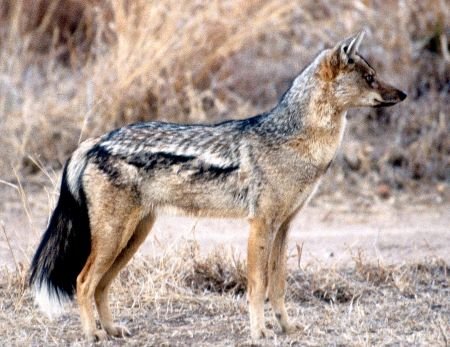
Picture a side-striped jackal as the ultimate survivalist. They find themselves in varied habitats—from savannas to woodlands, and even scrublands. It’s as if they’ve grabbed the best survival tips from various environments and decided to mix them into their daily lives. So, what’s their secret sauce? Let’s dig deeper into the fascinating world of side-striped jackals and find out how they make it work.
Understanding Their Habitat
Side-striped jackals (Canis adustus) are found primarily in parts of Africa, especially in areas where they have the flexibility to roam. These regions can be quite challenging, characterized by extreme temperatures and limited food resources. Imagine wandering around a neighborhood where every grocery store is closed—this is what survival feels like for many animals in harsh climates.
These jackals prefer habitats that offer a mix of cover and open space, like shrublands or grasslands, which is just like hunting for a cozy café to chill in while still having access to the bustling street outside. The shrubs provide shelter from predators and harsh weather, while open spaces help them locate prey more easily. They have a keen sense of smell and are often on the lookout for small mammals, insects, or even fruits and berries to snack on.
Adaptations for Survival
Surviving in the wild demands a unique skill set, and side-striped jackals have developed several adaptations. Firstly, their diet flexibility is impressive. They are opportunistic feeders, meaning they’ll eat whatever is available. This skill is crucial when food sources fluctuate. They might dine on rodents one day and shift to fruits or insects when small mammals are scarce.
Secondly, their social structure plays a significant role in their survival. Unlike some animals that prefer solitude, side-striped jackals often live in small family groups. This arrangement allows them to hunt and raise pups together, increasing their chances of finding food and safeguarding their young ones. You could say they’re like a tight-knit community, pooling resources and knowledge for survival.
Hunting Strategies
Hunting isn’t just a game of chase; it requires strategy and teamwork. Side-striped jackals are known for their clever hunting tactics. They often hunt in pairs or family units, allowing them to take down prey more efficiently. Imagine playing a team sport where everyone has to work together to score; this is how jackals approach hunting.
They also use stealth to their advantage. Moving quietly and with purpose, they stalk their prey before pouncing. This technique is especially useful in the dense brush, where being unseen can mean the difference between a successful meal and an empty belly.
A notable behavior is their ability to scavenge. They often follow larger predators, like lions or hyenas, to feast on leftovers. It’s a smart approach—why work harder when you can benefit from someone else’s effort?
Weathering the Elements
Surviving extreme weather conditions is another challenge for side-striped jackals. They’ve got a few ways to cope with heat and cold. For starters, they are most active during the cooler parts of the day, like dawn and dusk. Think of it as setting your alarm for early morning runs to avoid the midday heat—jackals are experts at timing their activities.
Additionally, they adjust their schedules based on season changes. In harsher climates, jackals may also dig burrows or find shelter in dense vegetation to escape the worst of the weather. This instinctual behavior not only helps them conserve energy but also protects them from predators.
Communication and Social Behavior
Effective communication is vital for survival, and side-striped jackals have mastered this art. They use a variety of vocalizations, including yips, howls, and growls, to convey messages to each other. This helps keep the family unit connected, whether they’re coordinating hunts or warding off intruders.
Body language plays a role too. Subtle movements and postures can indicate everything from readiness to play to signs of aggression. It’s fascinating how this signals a deep level of understanding among them; they seem to have a communal “language” that strengthens their bond.
Their social structure helps them navigate threats like larger predators or competing jackals. By working together, they enhance their chances of survival and create a supportive environment for raising their young.
Conservation Challenges
Despite their impressive abilities, side-striped jackals face numerous threats—mainly due to human activities. Habitat loss, often from agricultural development and urbanization, makes it hard for these creatures to find food and shelter. It’s like having your favorite hangout place turned into a shopping mall; they lose not just their home but also their unique way of life.
Additionally, they sometimes fall prey to disease, primarily due to the encroachment of livestock. When they attempt to hunt in these areas, they can come into contact with diseases that can be fatal, making survival even more challenging.
Conservation efforts are crucial to protect these fascinating animals and their habitats. By raising awareness and creating safe spaces for them to thrive, we can help ensure that side-striped jackals continue to navigate the harshest environments for generations to come.
The Bigger Picture
So why should we care about side-striped jackals? Well, they play an essential role in their ecosystem. As scavengers and hunters, they help control populations of smaller animals and contribute to the balance of their habitats. Losing them could disrupt this delicate balance, leading to unforeseen consequences.
Plus, the resilience and adaptability of the side-striped jackal serve as a reminder of the incredible ways life can thrive, even in adverse conditions. They teach us about survival, community, and the importance of respecting our natural world. Honestly, what more could you ask for from such a small creature?
In summary, side-striped jackals show us how adaptability and teamwork can help overcome the harshest environments. From their clever hunting strategies to their social structures and communication skills, these jackals are remarkable survivors. Embracing their story inspires us to think about how we can also adapt and thrive in our challenges—just like they do every day in the wild.
